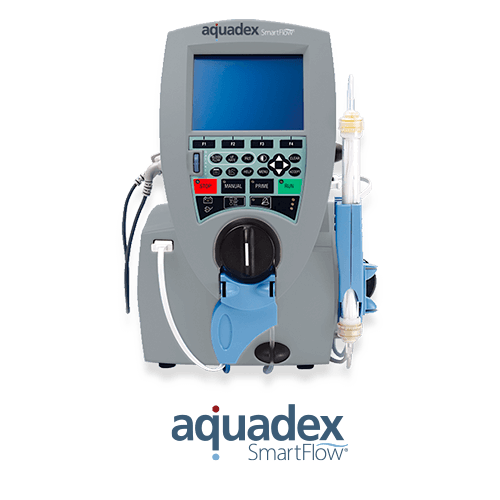Ultrafiltration
with Aquadex
SmartFlow®
ALWAYS FLUID, NEVER OVERLOADED
Aquapheresis therapy, delivered by the Aquadex SmartFlow System, uses a simplified approach to ultrafiltration for the removal of salt and water in patients with Fluid Overload.
With the Aquadex SmartFlow, medical practitioners can specify and control the amount of fluid to be extracted in a safe, predictable, and effective manner with the option of utilizing hematocrit monitoring to help inform therapy decisions.1
A SIMPLIFIED APPROACH TO ULTRAFILTRATION

- Can be prescribed by any physician trained in extracorporeal therapy
- Delivers safe and precise therapy with the ability to adjust the fluid removal rate and volume to meet each patient’s clinical need
- Approximately 35 ml of extracorporeal blood volume in our patented blood circuit
- No significant change to electrolyte balance
- Easy setup and monitoring allowing for a 1:4 nurse to patient ratio
- New Hematocrit and SvO2 features provide clinical insights and may help guide therapy decisions
RESTORING FLUID BALANCE, REDUCING RISK
The Aquadex SmartFlow System is indicated for:
Continuous ultrafiltration therapy for temporary (up to 8 hours) or extended (longer than 8 hours in patients who require hospitalization) use in adult and pediatric patients weighing 20 kilograms or more whose fluid overload is unresponsive to medical management, including diuretics.
Learn more about how Aquadex therapy helps restore fluid balance in all types of patients suffering from Fluid Overload.
CLICK AN INDICATION TO EXPLORE THE IMPACT OF AQUADEX
THERAPY GUIDELINES
Fluid Overloaded and with low diuresis/natriuresis on standard therapy
- Fluid >10 lbs over dry weight or > 5 pounds for patients weighing < 50 kg2,3
- Low urine volume on standard therapy (i.e., <100cc/hr)2
- Elevated serum creatinine or increasing serum creatinine on standard therapy2
- Unresponsiveness to diuretic therapy leading to persistent signs and symptoms of congestion3
Patient history
- Frequent hospitalizations due to fluid overload4
- Rehospitalized due to fluid overload5
Recommended*
- Minimum of 14 or 16 gauge lumen
- Central Venous Catheter such as:
- Dual lumen CVC with two 14 gauge lumens
- Dual lumen CVC with two 16 gauge lumens
- Quad lumen CVC with at least one 14 gauge and one 16 gauge lumen
- Dual lumen Extended Length Catheter (dELC) with coil
for peripheral access
- Central Venous Catheter such as:
NOT Recommended
- Catheters with lumen size smaller than 16 gauge: too small; do not provide sufficient blood flow
- PICC lines: too small, long, and soft; may collapse when blood is withdrawn
- Peripheral IVs: too small; do not provide sufficient blood flow
*Refer to Aquadex SmartFlow Directions for Use Appendix E Catheter Compatibility Guide for recommended catheter flow rates.
- Anticoagulation is recommended to prolong the life of the filter6,7
- Heparin is most commonly used (other anticoagulation agents may be used if contraindicated, such as Argatroban)6,7
- Anticoagulation is often administered at least 30 minutes prior to beginning therapy6,8
- Example therapeutic ranges:
- pTT = 80-100
- ACT = 180-220
- Anti-Factor Xa = 0.4-0.79
- For details, refer to your Standing Orders
- Always follow the appropriate and applicable local, institutional, and/or hospital policies, procedures, and requirements
- For patients with whom traditional anticoagulation recommendations are inappropriate, alternative strategies currently being used include:
- Non-weight based Heparin: gtt 300-600 units/hr (25,000un/250ml)- Prefilter i.e. via withdrawal access port10
- ECMO heparin protocols: narrower range of PTT (for example 40-60 sec general range)11
- Heparinized saline: to prime/reprime the circuit (for example 5000 units 500 ml normal saline or 5000 units in 1L normal saline)11-13
- Bolus of Heparin prior to initiation of therapy
- Non-weight based option: Heparin, 500-1000 unit bolus x1 during priming phase13
- Weight-based option: patient on Heparin gtt, with subtherapeutic PTT, bolus units/kg per Heparin protocol14
- Alternative administration sites for Heparin
- Pre-Filter administration via withdrawal access port, cardiothoracic surgery usually for
low doses (post CV surgery)
- Pre-Filter administration via withdrawal access port, cardiothoracic surgery usually for
- Citrate is not recommended due to its molecular size15
[1] SAFE Trial: Jaski BE, et al. J Card Fail. 2003 Jun; 9(3): 227-231. [2] Peterangelo M. Prog Cardiovasc Nurs. 2008;23:168-172. [3] Results of CHF Solutions MAB meeting. 2020. [4] ter Maaten JM, et al. Nat. Rev. Cardiol. 2015; 12(3): 184–192. [5] Testani JM et al. Circ Heart Fail. 2016;9(1):e002370. [6] Sniecinski R, et al. Best Practice & Research Clinical Anaesthesiology. 2015; 29, 189-202. [7] Oudemans-van Straaten H, et al. Critical Care. 2011; 15:202. [8] Hirsh J, et al. Circulation. 2001;103:2994-3018. [9] Byun, J., et al. Blood Research. 2016;51(3),171. doi:10.5045/br.2016.51.3.171. [10] Hirsh J, Anand SS, Haplerin JL, & Fuster V. Circ. 2001; 03:2994-3018. [11] Raffini L. . Am Soc Hematology. 2017. 674-681. [12] Ziyaeifard M, Alizadehas A et al. Anesth Pain Med.2015.5(4);e28056. [13] Skagerlind MS & Stegmayr BG. Europ J of Clinical Pharm. 2018:74(3):267- 274. [14] Peterangelo M. Prog Cardiovasc Nurs. 2008;23:168-172. [15] Davenport A & Tolwant A. 2009. NPT Plus. 2009; 2:439-447.

